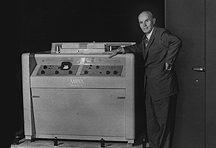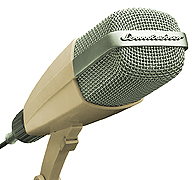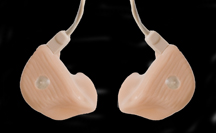2010
TECnology Hall of Fame
Audio Innovations
that Changed the (Pro Audio) World
By George Petersen
To expand the
scope of the TEC Awards, the TECnology
Hall of Fame was created in 2004 to spotlight
important innovations from the long and
rich history of the pro audio industry.
Each year, inductees are selected by
a committee of more than 50 industry
leaders, engineers, producers, designers,
educators, journalists and historians,
with the only “rule” being
that any selection must be at least 10
years old.
Once the results
are in, I research and write narratives
that put each into a historical context.
The process isn’t necessarily
easy. Many manufacturers are long since
out of business. At some companies, no
one remains who has any knowledge of the
product. Worst of all, the history of pro
audio—our very lineage—is woefully
neglected and sources are scarce, if not
impossible to find.
The TECnology
Hall of Fame is a continuing project,
with 95 inductees to date, with plans
to add more honorees in the’ future.
We encourage you to check out the inductees
from past years. Let’s all keep audio
history alive. And if you have any comments
or suggestions, let use know. We’ll
be listening.
George
Campbell/AT&T
First Audio Equalizer/Bandpass Filter
Electric Wave-Filter (1915)
George Ashley Campbell had a long and influential
career in developing technologies for the
audio, telephony and broadcast industries.
Born in 1870, Campbell graduated with a
B.S. degree from MIT and a master’s
degree from Harvard and joined AT&T’s
engineering department in Boston in 1897.
His initial research was in developing
means of improving the performance of long
distance telephone lines, which took the
form of inserting loading coils into phone
lines to avoid level losses and cut distortion.
Campbell later cited this research as part
of his doctoral thesis, which was awarded
by Harvard in 1901. Others—including
Michael Pupin and Oliver Heaviside— were
also involved in similar research, but
Campbell was first in creating a working
system and this application provided major
improvements in long distance telephone
quality.
Later, Campbell
focused much of his research on audio
filter development, creating the classic
L-C (inductor and capacitor) filters
that even today, are widely used in analog
tone control and filtering circuits. He
used the concept of combining simple high
pass (low cut) and high pass (high cut)
filters resulting in a more complex bandpass
filter, which was ideal for emphasizing
voice intelligibility over telephone lines.
These were accomplished using the now-classic “ladder
network” filters, so-called because
of their resemblance to ladders and documented
in Campbell’s 1915 patent application
(#1,227,113) for an “Electric Wave-Filter,” essentially
the first audio equalizer. Campbell’s
filter designs were later refined and expanded
by other AT&T researchers such as Otto
J. Zobel, who suggested a tunable “Wave
Filter” design in his 1921 patent
(#1,538,964). Beyond simple analog filtering
chores, the Wave Filter more importantly
paved the way for multiplexing—the
ability to run multiple voice conversations
over a single phone wire.
Ironically, this research for the modern
audio equalizer was completed years before
sound systems or even electrical recording
for records even existed. But the basics
of audio filtering had been laid and the
groundwork was ready to become part of
a revolution yet to come. George Campbell
died in 1954 at the age of 83, but had
been recognized by his peers for his four
decades of innovation. He was awarded the
IRE (Institute of Radio Engineers) Medal
of Honor in 1936, and four years later,
received the Edison medal by the American
Institute of Electrical Engineers.
|
Western
Electric 555-w compression driver
mounted
on
the end of the massive snail-coiled
Model 12-A horn. |
E.C. Wente & A.L.
Thuras
First High Frequency Compression Driver
Western Electric 555-w (1926)
There’s no doubt that 1926 marked
a busy era for audio technology. Electrical
recording—the use of microphones
and amplifier-driven cutterheads on record
lathes—was becoming a standard operating
procedure throughout the industry, and
the development of talking motion pictures
was underway. The industry suddenly needed
loudspeakers, with an emphasis on the word “loud.” A
year before, two General Electric engineers
(Chester Rice and Edward Kellogg) had unveiled
the modern dynamic cone loudspeaker, an
important step in the right direction.
However, with the low-power amplifiers
available at the time, any hope of providing
high-output reproduction was pretty much
out of the question.
Given that premise,
Edward C. Wente and Albert L. Thuras—two engineers from
Bell Laboratories—set out on a radical
solution. In a 1926 patent application
(#1,707,544), offered what they described
as “an acoustical device employing
an electrodynamic actuated vibrating element” using
a “light piston-type diaphragm which
is driven by a light rigid coil.” The
diaphragm/voice coil was set within a dense
electromagnetic structure fed a signal
from an amplifier and was designed to mount
onto a horn.
The resulting
product was the Western Electric Model
555-w “receiver,” and
the modern high frequency compression driver
was born. It’s surprising how close
the 555-w came to modern designs and how
little things have changed since then.
The original Wente-Thuras design featured
innovations such as a lightweight 0.002-inch
thin aluminum dome diaphragm with a corrugated
surround offering strength, stiffness and
flexibility; a phase plug; and a threaded
horn mount that allowed the driver to be
easily fitted on a variety of horns. The
picture shows the 555-w mounted on a Western
Electric Model 12-A, a huge, exponentially
tapered horn design that was 67 inches
tall, with a 45x45-inch throat opening
and an 11-foot overall pathway that provided
a frequency response as low as 80 Hz. Although
bulky, the driver/horn combination proved
highly efficient, and could achieve high
sound pressure levels from low-powered
amplifiers and could be used alone or combined
with cone woofers for extended low- frequency
performance.
|
Lansing Manufacturing
Iconic
monitor with top-mounted
multicell
horn/compression driver
and power
supply for supplying
voltage to the
speaker field coils. |
James B. Lansing/Lansing Manufacturing
Co.
First Recording Studio Monitor
Lansing Iconic (1937)
James B. Lansing founded Lansing Manufacturing
Company in 1927, initially to supply small
6- and 8-inch loudspeakers for radios.
With the ever-improving fidelity of home
radio sets, the company did well, but as
talking motion pictures became established,
Lansing was drawn to the challenge of building
extended–range loudspeaker systems
for film sound playback. In 1934, he supplied
15-inch woofers, compression drivers and
manufacturing expertise for the development
of Shearer Horn, the first large-scale,
high fidelity system for theater sound
reproduction.
Lansing later
turned to developing a monitor for film
mix stages, resulting in the Monitor
System 500, a single-15 driver in a folded-horn “W” box
with a sizeable model 805 multicellular
horn. Although a quarter the size of the
gargantuan Shearer Horn, the 500 was still
too large for most recording facilities.
With that in mind, Lansing began creating
the first recording studio monitor.
Developed in
1937, the Lansing Iconic was a compact
(about 40x25x18-inch) two-way system
with a 15-inch model 815 woofer in a
vented, bass reflex enclosure crossed
over at 800 Hz to an 801 compression driver
on a 808 multicell horn, for a response
that went from 30 Hz to 15k Hz and was
rated as flat (±2dB) from 45 to
10k Hz. Both drivers were electrodynamic
field coil (electromagnet) designs, requiring
an external power supply. Later models
were available with permanent magnets,
as well as “Salon” home versions
in furniture-style cabinets and component-only
kits for custom installations.
The Lansing Iconic was well-received among
recording and sound-reinforcement users
and remained in general use well into the
1940s and beyond. Among the many fans on
the Iconic system was Les Paul, who used
them in his recording studio.
Alec Harley Reeves
Pulse Code Modulation Patent (1939)
Discoveries occasionally occur long before
the current technology is ready to accept
and support it. And this is certainly the
case with British physicist Alec Harley
Reeves, who proposed one of the cornerstone
principles of digital audio, Pulse Code
Modulation (PCM), more than four decades
before introduction of the first commercial
digital audio recorder.
In his 1939 patent
for a “Signaling
System,” Reeves describes his invention
as a “system for transmitting complex
waveforms—for example speech—wherein
the waveform is scanned at the transmitter
at predetermined instants” and the “amplitude
range of the waveform to be transmitted
is divided into a finite number of predetermined
amplitude values according to the fidelity
required.” He also proposed a tube-based
PCM circuit, but this was in 1939—well
before the introduction of transistors,
ICs or microprocessors—and due to
the limitations of available technologies,
Reeves PCM proposal remained mostly unused
until the 1950s, when it was employed into
low-fidelity applications such as telephone
systems.
During World
War II, Reeves turned his efforts to
defense projects and proposed the OBOE
bombsight system used by the Royal Air
Force. Reeves authored dozens of patents
during his life and in latter years, he
was part of the research team at Standard
Telecommunications Laboratories that perfected
the use of fiber optics made from low-loss
glass. In 1969, 30 years after Reeves’ patent,
the British government honored PCM’s
role in advancing telecommunications technology
with a postal stamp. Reeves died in 1971
at the age of 69.
 |
Ampex
VRX-1000 with company
president Alexander
Pontiatoff |
Ampex Corporation
First Commercial Video Recorder
Model VRX-1000 (1956)
Technology is often filled with irony,
and the interesting part about the development
of the first commercial video recorder
is that its roots hail from audio innovators.
In fact, the concept stems from Bing Crosby’s
audio engineer Jack Mullin, who brought
the first German tape recorders to recorders
to America after World War II. Mullin demonstrated
them to Crosby, who fronted the capital
to Ampex to begin building audio tape recorders
in 1946. Four years later, with the advent
of television, Mullin talked to Crosby
about the notion of recording TV programs
on tape. A research project began, resulting
in a clunky—although functional—experimental
system with tape running over fixed heads
at 100 ips. Similar projects were also
underway at RCA and at the BBC.
In 1952, Ampex
began its own VTR project, with Charles
Ginsburg leading a team that included
Charles Anderson, Alex Maxey, Fred Pfost,
Shelby Henderson and the youngest member
of the team, a 19-year old kid named
Ray Dolby. But rather than a fixed-head
approach, Ginsburg was interested in pursuing
the (now-standard) concept of rotary tape
heads, proposed by engineer/inventor Marvin
Camras. The VRX-1000’s four tape
heads whirling at 14,400 rpm yielded a
tape speed equivalent to a fixed head deck
running at 1,500 ips, and could handle
the wide bandwidth requirements of video.
A 10-inch reel of 2-inch tape (the team
settled on using a 3M formulation) could
record 45 minutes and the VRX-1000 debuted
at the NATRB (later known as the NAB) show
in Chicago on March 14, 1956.
The first production unit (shown prior
to shipment in photo with Ampex founder
Alex M. Pontiatoff) was sold to CBS who
used the deck for tape-delay broadcasts
of news broadcasts in November of 1956.
Although the VRX-1000 cost $50,000 (an
enormous sum in the mid-1950s) and fewer
than 20 VRX-1000s were built, one thing
was clear. The days of live broadcasts
were numbered, and broadcasting and television
production would never be the same.
 |
Sennheiser MD
421 |
Sennheiser
MD-421 Microphone (1960)
Introduced in 1953, Sennheiser’s
MD 21 (“mikrofon dynamische” )
dynamic microphone was perhaps one of the
company’s most successful products.
Rugged, reliable, good sounding and available
in available in five colors, it was a hit
with European broadcasters and remained
in production for decades. However, the
basic, no-frills MD 21 was an omnidirectional
model, so in 1959, company founder Dr.
Fritz Sennheiser worked with his design
engineers Paul-Friedrich Warning and Johann-Friedrich
Fischer to take the design to the next
step.
The project was the MD 421, a rugged dynamic
mic that could provide a tight cardioid
directivity pattern that was consistent
at nearly all frequencies. It also featured
the capability to handle extremely high
sound pressure levels (up to 175 dB!),
a hum compensation coil to prevent EMI/RFI
interference and a 5-step low-frequency
attenuation circuit for tweaking bass response.
The MD 421 had to provide studio-quality
frequency response (30 Hz to 17 kHz) and
be able to be manufactured in relatively
large quantities. It was a tall order,
but the development team went to work.
In most studio (or live sound) mic designs,
the capsule and electronics are the most
difficult part of the design process, but
with the MD 421, extreme attention was
also paid to controlling low frequency
directivity and assuring consistent polar
response. This was accomplished using four
rear vents near the rear of the mic, felt
damping at the rear of the mic body, internal
damping within the capsule and a bass pre-emphasis
tube that provided airflow between the
capsule interior and a large air chamber
within the mic body. A cutaway diagram
of a MD 421 reveals the complexity of a
design that resembles a jet engine more
than a dynamic microphone.
The MD 421 body was made of DuPont Delrin
polymer resin, which had just become available
the year before and 50 years later, the
MD 421 remains one of the few professional
audio microphones featuring a molded (now
glass composite) body.
The MD 421 was
launched at Germany’s
Hannover Fair in 1960 and carried a price
tag of 180 Deutschmarks (about $45 USD).
The original version was available with
Tuchel or DIN output connectors; an XLR
version followed years later. But in any
version, the MD 421 was an instant success.
In fact at one time, the backorder situation
was so extreme that Sennheiser ran ads
with a bakery worker posing with trays
of mics coming out of the oven, to assure
customers and dealers that more MD 421s
were on the way.
Today, five decades years after its introduction,
the MD 421 remains in use worldwide in
broadcast as a vocal microphone and in
studios mostly as an instrumental microphone
capturing percussion, drums, guitar amps
and horns. The current incarnation of the
MD 421, the next-generation MD 421-II,
incorporates improvements such as a metal
inner chassis for better weight distribution,
a shorter, sleeker housing and self-sealing
(non-adhesive) acoustic connections for
improved serviceability. And with some
500,000 units in use since 1960, the MD
421 has definitely earned the well-deserved
distinction of an audio classic.
|
Sequential
Circuits
founder Dave Smith with
Prophet-5 |
Dave Smith
First Polyphonic Programmable Synthesizer
Sequential Circuits Prophet-5 (1978)
Once in a while a product comes out that
puts it all together—combining the
latest technology, while breaking new ground
and at the same time, filling a definite
void in the market. And as the first programmable
polyphonic music synthesizer, the Sequential
Circuits Prophet-5 was exactly that. An
analog synthesizer with the ability to
play five notes simultaneously (enough
for a chord) and having the memory capability
to store a whopping 40 preset programs
(later expanded to 120) might not create
headlines today, but the Prophet-5 was
a sensation in its time, and is still considered
a classic.
The path to success
wasn’t easy.
Sequential Circuits founder/chief designer
Dave Smith was excited about the prospect
of combining the sound generation capabilities
of the new ICs from Solid State Music (SSM)
that reduced the major functions of analog
filters and synthesis (VCO, VCA, VCF) into
single chipsets, reducing the number of
necessary components in an synthesizer
circuit from hundreds to a few handfuls.
At the same time, new microprocessors had
just come to market (such as the 8-bit
Zilog Z80), which while primitive by today’s
standards could definitely handle tasks
such as storing/recalling synth patches.
Once the ingredients were in place, Smith
worked with John Bowen (now of John Bowen
Synth Design) and with some consulting
help from E-mu founder Dave Rossum, the
Prophet-5 project was underway, and was
completed in just six months—an amazing
accomplishment.
On its debut
at the Winter NAMM show in January 1978,
the Prophet-5 was nothing less than a
hit. The SSM chips (later replaced with
Curtis ICs), combined with Smith’s
autotuning circuit kept the Prophet-5 in
tune—a problem that plagued many
early analog synths. Of course, its ease
of operation, great factory patches of
thick bass and lead sounds, and lush analog
string pads made the Prophet-5 quite desirable—even
at an original retail of $3,500 (later
$4,500). Soon every top keyboardist either
owned one—or wanted one—and
the Prophet-5 sounds became a common fixture
over radios everywhere, from punk bands
to Michael McDonald’s signature sound
on hits like the Doobie Brothers’ “What
a Fool Believes.”
The Prophet-5 stayed in production until
the mid-1980s and sold approximately 8,000
units. Today, Dave Smith continues creating
award-winning analog synthesizers with
his company, Dave Smith Instruments.
 |
Future Sonics
Ear Monitors™ |
Marty Garcia
First Commercially Available In-Ear Monitoring
System
Future Sonics Ear Monitors (1985)
The application
of headphone monitoring by onstage musicians
has been in use since the early 1970s.
These were mainly used by drummers, but
also by innovators such as Doobie Brothers
guitarist Jeff "Skunk" Baxter,
who found that headphone use in live
performance not only provided him with
improved listening but also protected
his hearing from excessive stage volumes.
The concept was good, but clunky headphones
weren't exactly the ideal solution. In
1978, inventor Steve Ambrose designed
and built the first in-ear monitoring
system, created as custom products for
Stevie Wonder and other top artists.
Several years
later, Marty Garcia—a
live sound engineer who operated Philadelphia-based
Crystal Sound and mixed hundreds of shows—experimented
using earpieces carrying a personal monitor
mix. Garcia began using consumer earbuds,
but after trials with a variety of top
performers, saw the opportunity for a more
specialized approach, and starting working
with audiologists to supply custom ear
molds.
In 1985, Garcia
was developing and refining his designs
for Ear Monitors® and Ears™-brand
earphone monitors. That same year, Todd
Rundgren used Future Sonics products on
his Utopia tour, the first wedgeless stage
with all band members wearing Garcia’s
Ear Monitors. Garcia founded Future Sonics
in 1991 and the word about his Ear Monitors
spread, with major artists such as Phil
Collins, Steve Miller and The Grateful
Dead joining the company’s growing
list of users.
Today, the use of earphone
monitoring is standard throughout the industry,
offering the advantages of reduced freight
requirements (by eliminating the need for
onstage wedges and sidefill speakers),
cleaner stages, lower onstage volume and
better monitor mixes for performers. And
the key to this revolution was Marty Garcia
of Future Sonics.
 |
Waves
founders Gilad Keren and Meir Shaashua |
Gilad Keren & Meir
Shaashua
First Audio Plug-In
Waves Q10 Paragraphic Equalizer (1992)
The concept of plug-ins—additions
that add functionality to established programs—date
back to text editors running on Univac
mainframes in the 1970s. By 1991, plug-ins
came on the scene, mainly as filter effects
sets for paint and photo manipulation software,
notably Digital Darkroom and Photoshop.
And although few realized it at the time,
the audio world was about to see some rather
significant changes in the years to come.
At the AES show in 1992, a new company
called Waves unveiled what was the first
audio plug-in. Created by founders producer
Gilad Keren and musician Meir Shaashua
(both also having extensive backgrounds
in math and engineering studies), the Q10
Paragraphic Equalizer was a little before
its time, but laid the groundwork for nearly
two decades of future success for the young
business. In addition to being the first
audio plug-in, the Q10 was groundbreaking
in other areas, offering quality that rivaled
or exceeded hardware units, while automating
complex filter coefficient calculations
and offering a clear, simple to use screen
interface.
The Q10 was anything
but an immediate success, but this was
hardly the fault of the product itself.
It ran on Digidesign’s
Sound Tools and early Pro Tools systems
where only a single plug-in could run at
a time. Two years later, the advent of
TDM (the open-architecture, 256-channel,
24-bit digital audio bus for Pro Tools)
opened the possibility of multiple plug-ins
on a single session and software-based
signal processing began evolving into an
integral part of modern audio production.
Today, Waves
(still with Keren and Shaashua at the
helm) has become a leader in digital
signal processing for the music recording,
gaming, live performance, broadcast and
film/video post-production industries.
And the Q10 that started it all is still
going strong (now updated to support TDM,
RTAS, Audio Suite, VST and AU platforms
and 24-bit/192kHz resolution) and is a
component in the company’s high-end
production bundles.
Dr. Harold Hildebrand
Antares Auto-Tune (1997)
Antares Audio Technologies was originally
founded in 1990 as Jupiter Systems by Dr.
Harold “Andy” Hildebrand, a
geophysical scientist who developed the
first standalone workstation for seismic
data interpretation. After nearly 14 years
in that industry, Hildebrand turned his
focus to merging his knowledge of DSP with
audio and music composition. Jupiter’s
first product was Infinity, an advanced
looping program, followed by 1994’s
MDT™ (Multiband Dynamics Tool), one
of the first commercial plug-ins for Digidesign’s
Pro Tools.
The huge breakthrough
came in 1997 with the launch of Antares
Auto-Tune plug-in (followed by a hardware
rack version) that could correct pitch
problems in vocals and other solo instruments.
Auto-Tune quickly became the best selling
audio plug-in of all time, and once the
general public became aware of it, the
technology was embroiled in controversy.
The erroneous impression was that automated
pitch correction meant that anyone could
perform with perfect pitch, leading to
the ruin of true music performance. However,
Auto-Tune was simply another production
tool, hardly different that punching
in a passage 75 times until it’s right, or �“comping” a
final vocal/solo by combining different
takes or using cut-and-paste editing to
replace a flawed chorus with a good one.
In fact, having
a pitch corrector in the vocal chain
can serve to enhance a vocal (live or
studio). By providing a musical “safety
net,” a performer could concentrate
on the overall performance without worrying
about that one tricky note, resulting in
a better take, even without the Auto-Tune
kicking in. And in a live setting, any
real performance is preferable to the lip-synced
vocal playbacks on many tours today.
Today Auto-Tune
is in its seventh generation and now
offers both pitch- and time-based correction.
And more than a decade later, it’s
more popular than ever, not only for
fixing a note or two, but sometimes also
used “turned up to 11” to
provide an exaggerated perspective on instruments
and vocals—such as the iconic Cher/T-Pain-style
Auto-Tune effect—or in a completely
different vein, to bring musicality to
a narrated vocal track.
TECnology Hall
of Fame director George Petersen is also
the executive editor of Mix magazine
and an engineer/producer who’s
most recent project is “Voodooville:
A Celebration of New Orleans,” a
5.1 surround-audio DVD of jazz/funk/blues/Creole
music.
home | sitemap
| contact |

